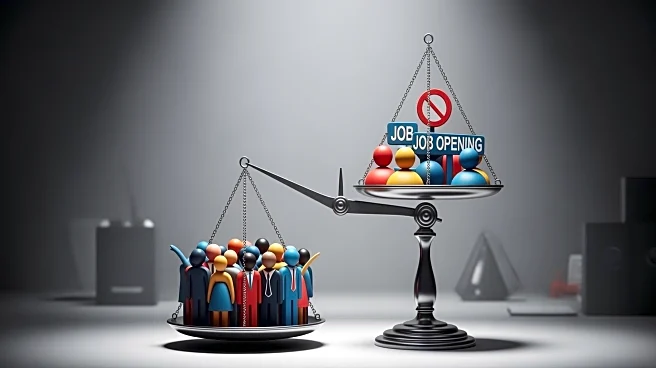What's Happening?
Economists and strategists on Wall Street are increasingly concerned about the U.S. job market entering 'stall speed,' a term borrowed from aviation that describes a significant slowdown in job creation. This situation could lead to a self-reinforcing
cycle of job losses and potentially trigger an economic downturn. Peter Berezin, chief global strategist at BCA Research, suggests that the job market is on the verge of stall speed, which could elevate the unemployment rate to 6% from the current 4.2%. This concern is echoed by economists at JPMorgan and Goldman Sachs, who have noted lackluster job data and comments from Federal Reserve Chair Powell about the risk of higher layoffs and rising unemployment. The U.S. job market has shown signs of weakening, with job gains in recent months being revised downward and private payrolls data indicating potential further deterioration.
Why It's Important?
The potential entry of the U.S. job market into stall speed is significant as it could lead to increased unemployment and a possible recession. A slowdown in job creation affects consumer spending, which in turn impacts businesses and can lead to more layoffs, creating a vicious cycle. If the unemployment rate rises significantly, it could have widespread implications for economic stability and growth. The Federal Reserve may need to consider cutting interest rates to stimulate hiring and prevent further economic decline. The situation poses risks to various stakeholders, including workers, businesses, and policymakers, who must navigate the challenges of a slowing labor market.
What's Next?
Economists are closely monitoring upcoming economic data, including private payrolls, initial jobless claims, and the U.S. jobs report, to assess the health of the labor market. The Bureau of Labor Statistics' annual revision of jobs data in September is expected to provide further insights, with potential downward revisions indicating fewer jobs added than initially reported. If the August jobs report shows continued weakness, the narrative of an impending recession may gain traction. Policymakers and financial institutions will need to respond to these developments to mitigate the risks of a prolonged economic downturn.
Beyond the Headlines
The concept of stall speed in the job market highlights the interconnectedness of consumer behavior, business performance, and employment rates. As consumers become cautious and reduce spending due to job insecurity, businesses may face reduced demand, leading to further layoffs. This cycle underscores the importance of maintaining a robust labor market to ensure economic resilience. The situation also raises questions about the effectiveness of monetary policy in addressing labor market challenges and the need for comprehensive strategies to support job creation and economic growth.













